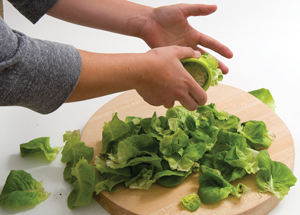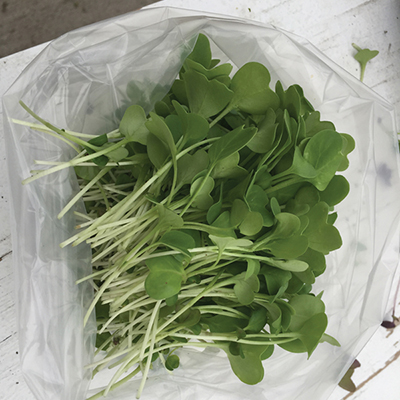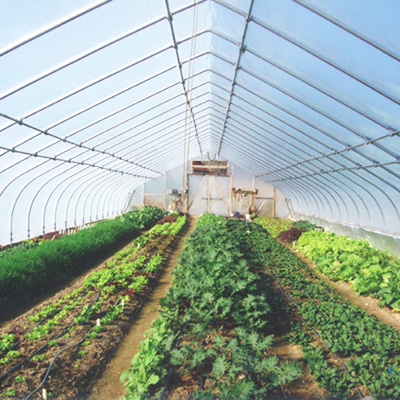There is a new kind of lettuce that could change the way you grow salad mix. You may have noticed it while looking through seed catalogs this winter. It goes by several trade names including Eazyleaf, Multileaf and Salanova. Available to the large-scale bagged salad mix industry for a few years, it is available to smaller growers for the first time this year. I don’t think it will ever completely replace densely sown baby leaves, but for many growers, it may have advantages. It is an innovation that offers benefits both for the grower and the eater over the traditional salad mix.

For the grower, it offers higher yield, better profitability, longer shelf life, easier harvest, and more loft than baby leaf salad mix. For the eater it offers better flavor and texture. You probably won’t find yourself bragging to your customers about increased shelf life. But when they stick your bag of salad in the fridge and forget about it for a few days, and it’s still good whenever they get around to eating it, they’ll appreciate that too.
Salad mix status quo
The ubiquitous presence of salad mix at every farmers market and grocery store in the land is testament to its value to growers and eaters. For farmers, it is a popular, profitable product. For eaters, it offers a convenient way to eat healthy. Just empty out a bag, pour on some dressing and POW! You’ve got a salad. That’s the kind of convenience people are willing to pay for.

Most growers I visit use the baby leaf method of producing salad mix. Seed is densely sown directly in the field, and the immature leaves are cut one or more times. I got an education in salad mixology in 2004 when I apprenticed at Full Circle Farm in Carnation, Washington. Their relatively mild weather wasn’t great for outdoor fruiting crops, but they could really grow greens.
I would guess we were shipping 1,000 to 2,000 pounds of beautiful, organic salad mix per week that summer. The farmer made it look easy. A seeder behind the tractor planted wide, long beds of baby leaf lettuces. An Italian harvest tractor’s front-mounted bandsaw blade cut the leaves from the earth. A conveyor belt moved the leaves up into bins. A commercial triple-washer cleaned the greens before they were spun dry and packed up for sale at farmers market, CSA, and regional grocery stores.
Though my ambitions as a farmer are smaller scale than Full Circle Farm, it certainly was a worthwhile education on how to scale up. This kind of salad mix production is streamlined and efficient, but one of the challenges is eliminating the little bits of leaf that inevitably make it into the bag. When the blade cuts off ragged edges from the previous cut, or very small leaf tips from new leaves at the center of the plant, these little bits are the first things to rot and end up shortening the life of the whole bag.
One of the great things about that apprenticeship at Full Circle was that we got to go visit farms in the area to see how other farmers did things. We found one guy who made an impression on me hunched over out in his field, cutting salad mix. There was an audible creak as he stood up to give us the tour.
“There are only two things you need to harvest salad mix,” he said, holding out both hands. In one, he had a harvest knife; in the other, a bottle of aspirin.
An incomplete history of salad mix
If you go looking for the history of salad mix, you will find references to various herbivores, salad-loving Romans, and of course French mesclun. But there is not much to explain how the modern American incarnation with plastic bags of ready-cut salad got everywhere. Before some certain point in our history, lettuce was something that was sold by the head.
I caught a glimpse of the murky origins of bagged salad from Dave Colson of New Leaf Farm in Durham, Maine. On a tour of his farm, he showed us how he made salad mix by cutting the top off a nearly mature head lettuce plant. Colson said he picked up this technique when working on a farm in California in the late seventies or early eighties, back when there was no such thing as bagged salad mix on store shelves.
“We were having 30-50% loss in the field, due to heads not sizing up, or aster yellows, or something else making the heads unmarketable,” said Colson. “So cutting it was a secondary use — a way of getting something marketable out of what would otherwise be left in the field. Once we started selling it we realized we could make more money selling it as salad than as heads.”
The difficulty with using head lettuces for salad mix production, Colson points out, is that not every variety of head lettuce makes a nice bite-sized leaf. The best ones for this type of production are the deeply lobed oakleaf and frisee types, which make fairly small leaflets when cut above the growing point. The worst are what Colson calls the “paddle-shaped leaves,” like romaines, that have to be ripped up to be bite-sized.
Restaurants actually prefer his salad mix made from head lettuce over baby leaf, because it has so much more loft than the immature baby leaves. They can put less weight on the plate and still be a full serving.

The pendulum swings back
In the intervening decades since bagged salad mix conquered the world, hundreds of baby leaf lettuce varieties have been developed to feed the industry. The breeding has focused on different colors, shapes, textures, and the ever-mutating strains of downy mildew that thrive in California, where a large percentage of the nation’s salad mix is produced.
Farms have had great success producing tons of baby leaf salad mix by seeding it, mowing it, bagging it and shipping it all over the place. But there were improvements that could be made. The yield is relatively low; that is, you have to have a lot of space devoted to it for a high yield. Baby leaves of most varieties tend to be flat and stick together when washed. If you want a second or third cutting, you end up cutting ragged edges from the last cuttings. So breeders continued working on developing head varieties specifically to overcome these problems.
The features of these new cutting lettuce varieties that differentiate them from baby leaf and traditional head lettuce are:
Individual leaves stay small: even when mature, the leaves remain bite sized, about the same size as baby leaf lettuce.
Better flavor and texture: Because the leaves are from a mature plant, they have a fully developed midrib and thicker leaf that adds crunch and flavor. Mature leaves take up more space, giving the mix more loft for the same weight of baby leaves.
The “incised leaf” types have leaves attached to a single point at the base, so one cut releases all the leaves. Their leaf shapes are similar to frisee or lollo types of lettuce. These can be mechanically harvested or cut in the field with a knife. If they are cut below the growing point, the whole head can be taken to a packing area and cleaned and processed into salad mix there, or sold to the end consumer as a head.
The “multi-leaf” or “cored” types have leaves attached to a central core. The cored types produce leaf shapes similar to a butterhead or oakleaf types of lettuce. The heads can be mechanically harvested but they will not fall into individual leaves until “cored” with a special cutter tool, or with a knife. Or the entire head can be sold to the customer for them to process themselves.

Higher yield, lower expense
Field trials have shown that heads grown for salad mix will produce 40% or more per area than baby leaf. Growing the head to maturity takes about 55 days vs. 30 days for baby leaf. If you transplant the heads, they will produce 40% more in about the same amount of time as direct-seeded baby leaf. One planting of head lettuce may yield around 270#/1,000 square feet, whereas baby leaf may yield around 190#/1,000 square feet.
Based on a baby leaf planting rate of 400 seeds/square foot and a head planting rate of 1 seed/square foot, the cost to plant 1,000 square feet of baby leaf is $188 whereas head lettuce (including transplant production cost) is $142. Though the individual seed cost is more than baby leaf varieties, so much less seed is used that overall expense is lowered.
The combination of increased yield and lower seed cost would represents a profit increase of 92% per dollar spent on head lettuce over the production cost of baby leaf.
Other advantages
Easier to Cultivate: Since it grows as distinct plants on 6-8” spacing instead of tightly packed direct seeding, cultivation between plants and rows is easier.
Customizable Mixes: The deeply cut, three-dimensional leaves of the incised types add loft and weight to the mix. The cored types provide deeper colors and flavors. Ratios of each type can be customized for your own unique salad mix.
Longer Shelf Life: Leaves from mature plants store longer than baby leaves. Thicker, more mature leaves hold up to washing better. Because there are no bits and leaf tips from previous cuttings, the salad lasts longer without small pieces rotting in the bag.
Easier Harvest: Can still be harvested mechanically for growers with equipment. For those who harvest by hand, it is typically quicker to harvest head by head instead of leaf by leaf. It certainly appeals to me more to harvest a head at a time, and process it standing up in the comfort of my packing shed.
Suitable for Hydroponic Production: Most hydroponic systems do not offer any way to grow densely sown baby leaf lettuce. Because this grows as a head, it works well in most hydroponics, including NFT (Nutrient Film Technology) and deep water systems.
Disease Resistant: Modern disease resistance packages including multiple races of downy mildew, LMV, and Nasonovia ribisnigri aphid.
In addition to the above reasons, using a head of lettuce to produce salad mix appeals to me for use on my farm because our results with baby leaf have been so mixed. Sometimes it comes up well and we are happy with the result. But getting it planted at the proper density can be tricky, especially with inexperienced workers sometimes doing the seeding. We have had it planted too thickly and too thinly, both of which throw off the expected yield.
Growers’ experience
We have yet to get the weed situation completely under control on my farm, so regardless of how well the baby leaf was planted, we end up wasting time at the washing stage picking in-row weeds out of the salad mix. These can run from grass and clover (not a huge problem if we don’t get them all out), to thistle (ouch, we lose a customer if we don’t get it all).
The last few years in central Maine, we have had very wet springs, which have abruptly switched over to hot, dry summers. Getting direct seeded crops planted and germinated in either extreme can be a challenge for us. We don’t have overhead irrigation in our field so we are at the mercy of the rain gods when it comes to germination in the summer. Since we produce lots of transplants for our seedling business anyway, I’d rather just grow transplants that I’m pretty sure will survive and produce a certain amount in a timely fashion.
“What, now we have to grow transplants for salad mix?!?” was the reaction of my wife, Ann, who manages production of all the transplants on our farm, when I first told her about the idea of growing heads for salad mix production. But I brought some seed home this past fall and she was convinced by the quality and flavor that this is lettuce worth producing transplants for. That, and the fact that the day we cut a bed, we can replant it with transplants that will produce 40% more than direct seeding would in about the same amount of time.
I was able to talk to a couple of other growers who trialed these varieties last year. Michael Kilpatrick of Kilpatrick Family Farm in Middle Granville, NY, said: “The yield per square foot is very good; it really pays for itself. We were already transplanting salad mix so that’s not a new expense for us.”
Kilpatrick said they were able to cultivate with basket weeders once and Lely weeders twice and that after three cultivations there were not many weeds left. “We can cultivate it a lot easier than baby leaf salad mix, which is a huge cost savings for us.” He said they were able to hold whole heads in cold storage for 4-6 weeks, then process them and have fresh salad mix at winter markets.
I also talked to Paul Arnold of Pleasant Valley Farm in Argyle, NY, about his experience this past season. Arnold said he grows mini-head varieties for salad mix, and that he found the production of Salanova extremely high and the disease resistance good. Arnold said he was not sure if he would grow them in a tunnel over the winter, since he thought that a crop you could cut and come again, like spinach, might be more profitable.
Both Kilpatrick and Arnold said they were going to switch 40% of their salad mix production over to Salanova this coming year, with possibly more in coming years after they develop a more extensive track record with it.
Salad mix has come to rule the lettuce world, and baby leaf production has come to rule salad mix. I hope this article has given you the tools to evaluate whether using specialized head varieties to produce salad mix has a place on your farm, with or without baby leaf. Beyond the advantages in the field, the superlative culinary qualities will give growers a way to differentiate their product at market in a world full of salad mixes.
Sources
The Salanova brand is available from Johnny’s Selected Seeds, www.johnnyseeds.com
The Multileaf brand is available from Harris Seeds, www.harrisseeds.com, and Osborne Seed, www.osborneseed.com, and other retail seed companies.
Eazyleaf is not currently in retail catalogs but is sold directly to large growers by the breeder, Enza Zaden, www.eazyleaf.com.
Andrew Mefferd runs One Drop Farm in Cornville, Maine, with his wife, Ann, and does variety trialing for Johnny's Selected Seeds at the research farm in Albion, Maine.
For more useful articles about market farming, become a Growing for Market subscriber! You can opt to receive GFM by mail, read it online, or become a Full Access member with access to an archive of more than 1,400 articles published from 2001 to the present. Click here to see subscription options.













